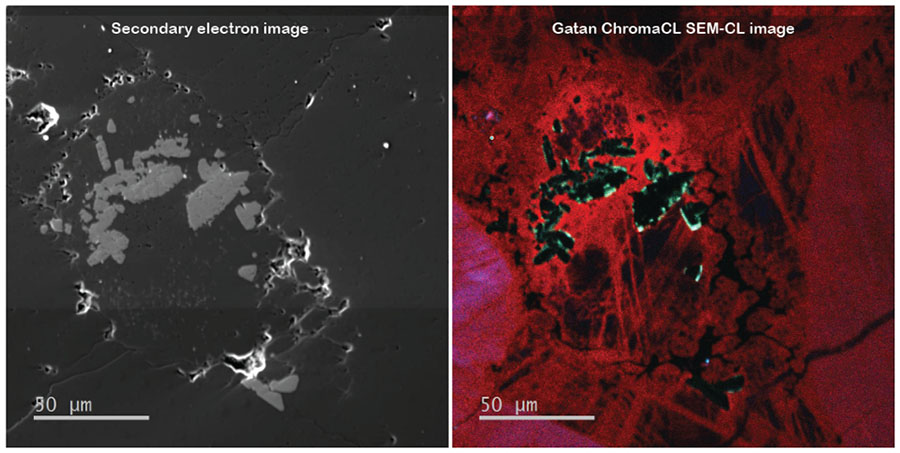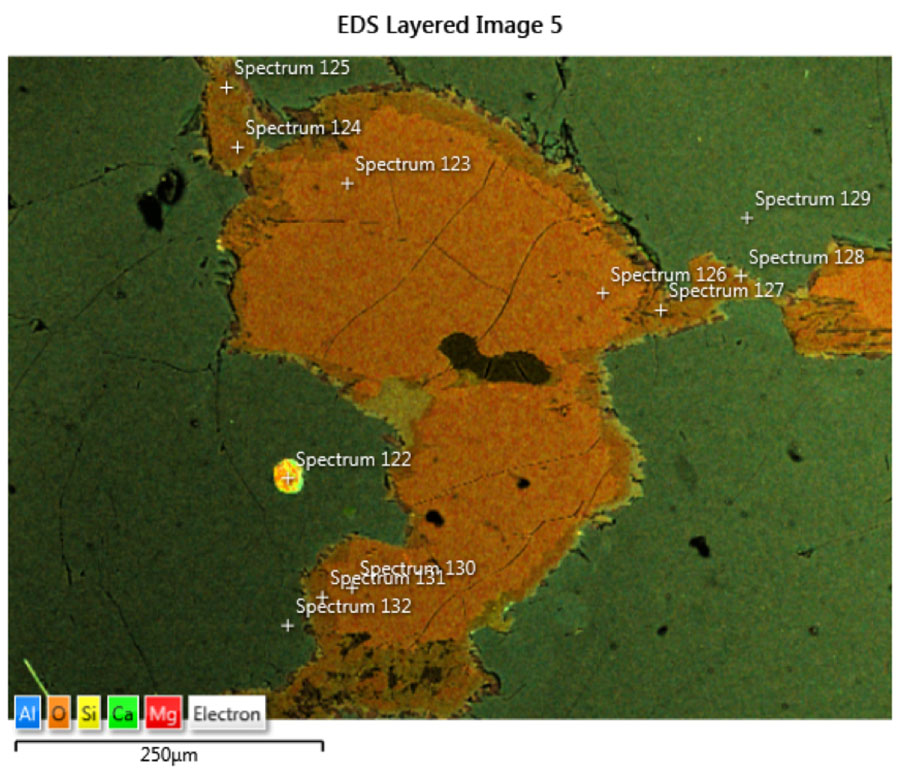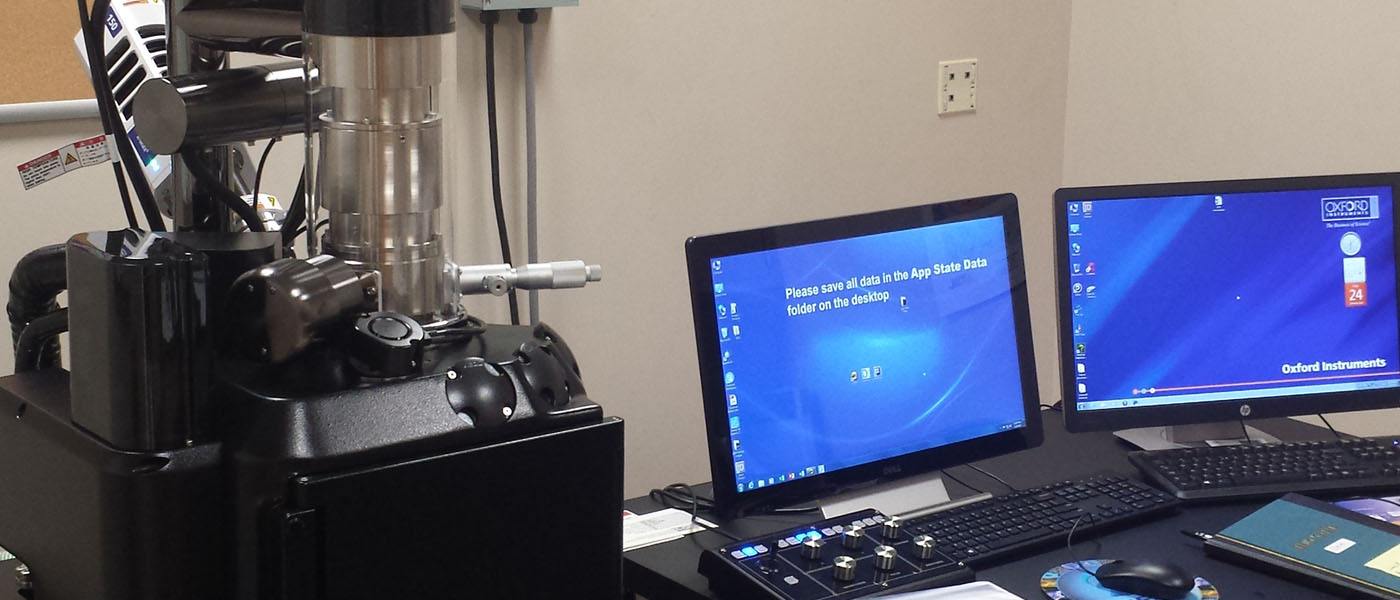BOONE, N.C.—The National Science Foundation, through a major research instrumentation program grant, awarded the College of Arts and Sciences’ Dewel Microscopy Facility at Appalachian State University $562,842 for a new scanning electron microscope (SEM).
The SEM contains detectors that allow for rapid, detailed analysis of materials and make Appalachian’s microscope the only one of its kind in the UNC system.
Since its installation last spring, the SEM is in heavy use for teaching and research across academic disciplines at Appalachian.
The tool is being applied in the Biology, Anthropology, Geological and Environmental Sciences, and Physics and Astronomy departments to further research in a variety of studies such as meteorite classification, metamorphism of ultra-high pressure rocks in the Caribbean, early fossil assemblages, the effect of climate change on Fraser fir trees, vascular changes during pregnancy and the microbial ecology of peat bogs, among a variety of other archaeological studies.

An image of sand grains from Erwin Quartzite in eastern Tennessee made possible by the SEM and its Chroma CL detector. The gray secondary electron image on the left is made from electrons bouncing off the surface of the rock, and does not show much detail. The cathodoluminesence image on the right shows the identical sand grains, but shows the light emitted from the surface. The odd red pattern and structures shown in the right image could be from defects in the sand grain crystal structures, or from trace elements in the sand grain that distort the crystal structure. Photo by Drs. Sarah Carmichael and Gabriele Casale
“The SEM is modern and user friendly. It has tons of redundancy safety measures, an easy-to-use interface, and even touch screen control. This means that in terms of the educational big picture, we now have a state-of-the-art machine that can be competently operated by student researchers. It’s even easy enough that high school groups can come here in the summer and get experience,” said Dr. Gabriele M. Casale, assistant professor of structural geology in the Department of Geological and Environmental Sciences.
The SEM uses a focused beam of high-energy electrons to generate a variety of signals at the surface of solid specimens. The signals that derive from the electron-sample interactions reveal information about the sample, including external texture, chemical composition and crystalline structure of materials making up the sample. It is the only instrument that provides such a wide variety of applications in the study of solid materials. Basically, SEM imaging uses electrons instead of light to image tiny objects, such as bacteria.
“The SEM is a tool that allows us to peer into objects so small that normal light microscopes, and therefore our eyes, cannot resolve. On the SEM, we are very easily able to examine physical features of geological and biological materials that are mere millionths of meters in size,” said Casale.
There are two new and different detectors in the SEM that allow for rapid, detailed analysis of materials and make the microscope applicable for forensic science, material science and engineering. These detectors are the Chroma CL detector, which makes it possible to learn the elemental composition of samples by colorful images that cannot be seen with normal light, and an Electron Backscatter Diffraction (EBSD) detector, which makes the SEM sensitive to incident electrons ejected from the sample being studied.

A map created with the new scanning electron microscope of reactions between pyroxene and feldspar crystals in the Farmington Gabbro, an igneous rock unit (from magma that was trapped underground and cooled) that is being mined for aggregate by Vulcan Materials. Each color corresponds to a different element. Photo by Bonnie Nguyen, Tristan Bedell, Jesse Kimel, and Lauren Richardson.
With the Chroma CL detector, “It’s sort of like turning on a black light and seeing fabric softener that didn’t wash off, or the way a butterfly might see a flower, which is different than how we see them. The objects look the same but give off patterns that relate to physical or chemical characteristics that we normally cannot see,” said Casale.
The EBSD detector is sensitive to incident electrons ejected from a mineral sample. Since these electrons are ejected in a pattern that is unique to each mineral and sensitive to minor distortions, the sample can be evaluated for structure and orientation at the molecular scale.
“You can think about a crystal lattice as lots of tiny mirrors, like a tiny kaleidoscope, so the reflections make patterns. The pattern is unique to every different crystal lattice, and more importantly, every lattice orientation. The EBSD is useful because it can show the orientations of literally millions of microscopic crystal lattices in just a few short hours,” explained Casale.
The growth or changes to the formation of these lattices is a tiny footprint of the changing chemical or physical conditions in our environment, that can provide a snapshot of history through millions of years of plate tectonic shifts or processes in nature.
Eventually, the SEM will have remote capabilities, so that operation and research can be conducted from locations outside of the lab.
To learn more about the William C. and Ruth Ann Dewel Microscopy Facility, visit http://cas.appstate.edu/about/research-facilities. For more information about research projects and facilities at Appalachian, visit http://appstate.edu/research.
About the William C. and Ruth Ann Dewel Microscopy Facility
The facility serves undergraduate, graduate students and faculty at Appalachian, offering a wide variety of services in light and electron microscopy and image analysis. The facility, located in the Rankin Science building, supports both research and teaching, and provides instruction and assistance on the use of state of the art imaging equipment. Scholarship is fostered through collaborative research and instruction among all invested departments in the College of Arts and Sciences and the greater scientific community. Outreach activities encourage the development of learning and creative research at the local and regional level.
About the College of Arts and Sciences
The College of Arts and Sciences (CAS) at Appalachian State University is home to 17 academic departments, two centers and one residential college. These units span the humanities and the social, mathematical and natural sciences. CAS aims to develop a distinctive identity built upon our university's strengths, traditions and locations. The college’s values lie not only in service to the university and local community, but through inspiring, training, educating and sustaining the development of its students as global citizens. More than 6,800 student majors are enrolled in the college. As the college is also largely responsible for implementing App State’s general education curriculum, it is heavily involved in the education of all students at the university, including those pursuing majors in other colleges. Learn more at https://cas.appstate.edu.
About Appalachian State University
As a premier public institution, Appalachian State University prepares students to lead purposeful lives. App State is one of 17 campuses in the University of North Carolina System, with a national reputation for innovative teaching and opening access to a high-quality, cost-effective education. The university enrolls more than 21,000 students, has a low student-to-faculty ratio and offers more than 150 undergraduate and 80 graduate majors at its Boone and Hickory campuses and through App State Online. Learn more at https://www.appstate.edu.
What do you think?
Share your feedback on this story.












